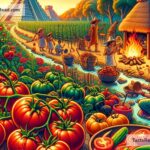The Ancient Uses of Coconuts in Island Cultures
Coconuts are one of the most fascinating plants in history. They’ve been an important part of island life for thousands of years, and their uses go far beyond just food and drink. For many island cultures, coconuts were not only practical but also symbolic of life and survival. Let’s explore how ancient island communities used coconuts in their everyday lives.
The Coconut Tree: A “Tree of Life”
Island cultures often referred to the coconut tree as the “tree of life.” This wasn’t just a poetic name—it was a reflection of how the coconut tree provided so much for them. From its roots to its fruits, every part of the coconut tree could be used for something valuable. In places like Polynesia, Micronesia, and Southeast Asia, coconuts became central to survival and cultural identity.
Food and Drink
Coconuts were an essential source of food and drink for ancient islanders. The coconut fruit provided both solid and liquid nourishment. The tender flesh (called “meat”) inside a young coconut was eaten raw and acted as a natural energy booster. Older coconuts had firmer meat that could be dried or cooked into various dishes. The versatility of coconut meat made it a key ingredient in many traditional island recipes.
The coconut water found inside young coconuts was also highly prized. It was nature’s refreshing drink, full of nutrients and electrolytes. Islanders relied on coconut water to stay hydrated in hot, tropical climates, especially during long trips across the sea on fishing or trading expeditions. For pregnant women and the sick, it was often a gentle and nourishing drink.
Coconut oil, extracted from the meat, was widely used for cooking. The oil added flavor and richness to meals and lasted a long time, making it a valuable ingredient for island communities.
Shelter and Tools
Ancient islanders were incredibly resourceful, and the coconut tree was their best ally when it came to building shelter and tools. The sturdy trunk of the tree was used to make building materials, such as pillars and posts for houses or community gathering spaces. Coconut wood was durable and could withstand tropical storms, making it reliable for construction.
The leaves of the coconut tree were used as roofing materials. Islanders would weave the long, green fronds into mats to create waterproof roofs for their homes. Not only were these roofs functional, but they also kept homes cool by allowing air to flow through the gaps in the weave.
In addition to shelter, the coconut provided materials for tools and everyday objects. For example:
– Coconut shells: These were used as bowls, cups, and storage containers. Polished coconut shells could even be turned into jewelry or decorative items.
– Coconut fibers: The husk (outer layer) of the coconut was rich in fibers that could be twisted into ropes, mats, or fishing nets. These were strong and long-lasting, ideal for island life.
– Palm leaves: Beyond roofs, the leaves of the tree were also woven into baskets, fans, or even clothing in some cultures.
Medicine and Natural Remedies
Coconuts were also used for health and wellness in ancient island cultures. Coconut oil was applied to skin wounds and burns as a natural remedy. Its antibacterial properties helped prevent infections and aided in healing. Islanders also used coconut oil to keep their skin smooth and protect it from the harsh sun and salty sea air.
The fibers from the husk were sometimes boiled and used to treat fevers or to clean wounds, while coconut water was considered a revitalizing drink for those recovering from illness.
Transportation and Trade
Coconut trees even played a role in transportation and trade. Canoes were sometimes crafted using the wood of the coconut tree. These canoes allowed islanders to travel between islands, fish, and explore new lands.
Coconuts themselves became a valuable trading item. Their long shelf life meant they could be transported across great distances without spoiling. Obviously, coconuts didn’t just provide sustenance—they also became part of the rich trading networks that connected ancient island cultures.
Spiritual and Cultural Significance
In many island cultures, the coconut held symbolic and spiritual meaning. It was seen as a gift from nature or the gods and was often used in religious rituals. For example, in Polynesian cultures, the coconut was sometimes offered as a sacrifice to deities or ancestors. Some communities believed that the coconut represented life itself, containing water (the essence of life) and nourishing meat (sustenance for survival).
Coconuts were also integral to storytelling and legends passed down through generations. In Hawaii, there’s a famous legend about the coconut tree’s origins, telling of its link to love and sacrifice. Such stories reflect the deep connection between island communities and the coconut tree.
Conclusion: A Timeless Treasure
The coconut tree truly was a miracle for ancient island cultures. Its fruit provided food and drink, its leaves offered shelter, and its fibers turned into ropes and mats. Even today, coconuts remain an essential part of life in tropical regions, proving that ancient islanders understood the value of this amazing tree.
The next time you sip coconut water or enjoy coconut meat in a dish, think about its long history. It’s not just a tasty treat—it’s a timeless treasure with deep cultural roots. For islands around the world, the coconut has always been much more than a fruit; it’s been a symbol of resilience, resourcefulness, and harmony with nature.


